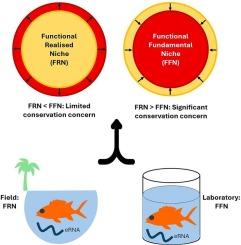Commentary: Environmental RNA and the assessment of organismal function in the field
IF 1.9
3区 生物学
Q4 BIOCHEMISTRY & MOLECULAR BIOLOGY
Comparative Biochemistry and Physiology B-Biochemistry & Molecular Biology
Pub Date : 2024-09-21
DOI:10.1016/j.cbpb.2024.111036
引用次数: 0
Abstract
Environmental RNA (eRNA) is an emerging technique with significant potential for the assessment of organismal function in field settings. It has the advantage of being non-invasive, facilitating insight into the physiological status of an organism without complications associated with processes such as capture, handling, and transportation from the field to the laboratory. It is hypothesised that eRNA approaches will be especially valuable for assessing sublethal stress of species living in environmental settings undergoing change and could therefore be integral for examining population health and for testing hypotheses regarding organismal physiology developed from laboratory studies. However, the successful application of eRNA approaches requires further data regarding the stability and persistence of eRNA in natural substrates; established and validated relationships between molecular biomarkers and the physiological processes they participate in; and an understanding of the contributions of different epithelia in direct contact with the environment (skin, gill, gut) to the eRNA transcriptome. The utility of microRNA as a component of the eRNA pool should be an area of specific future research focus. Ultimately, eRNA has the potential to provide fundamental physiological information regarding the responses of organisms in their natural settings and could increase the sensitivity and acuity of biomonitoring efforts.

评论:环境 RNA 和实地生物功能评估。
环境 RNA(eRNA)是一种新兴技术,在野外生物功能评估方面具有巨大潜力。它具有非侵入性的优点,有助于深入了解生物体的生理状态,而不会出现捕获、处理和从野外到实验室运输等复杂过程。据推测,eRNA 方法对于评估生活在环境变化环境中的物种的亚致死压力特别有价值,因此可以成为检查种群健康和检验实验室研究中提出的生物生理学假设的组成部分。不过,要成功应用 eRNA 方法,还需要以下方面的进一步数据:eRNA 在天然基质中的稳定性和持久性;分子生物标记物与其参与的生理过程之间已建立和验证的关系;以及对与环境直接接触的不同上皮(皮肤、鳃、肠道)对 eRNA 转录组的贡献的了解。作为 eRNA 库的一个组成部分,microRNA 的效用应该是未来研究的一个重点领域。最终,eRNA 有可能提供有关生物在自然环境中反应的基本生理信息,并可提高生物监测工作的灵敏度和敏锐性。
本文章由计算机程序翻译,如有差异,请以英文原文为准。
求助全文
约1分钟内获得全文
求助全文
来源期刊
CiteScore
4.60
自引率
4.50%
发文量
77
审稿时长
22 days
期刊介绍:
Comparative Biochemistry & Physiology (CBP) publishes papers in comparative, environmental and evolutionary physiology.
Part B: Biochemical and Molecular Biology (CBPB), focuses on biochemical physiology, primarily bioenergetics/energy metabolism, cell biology, cellular stress responses, enzymology, intermediary metabolism, macromolecular structure and function, gene regulation, evolutionary genetics. Most studies focus on biochemical or molecular analyses that have clear ramifications for physiological processes.

 求助内容:
求助内容: 应助结果提醒方式:
应助结果提醒方式:


